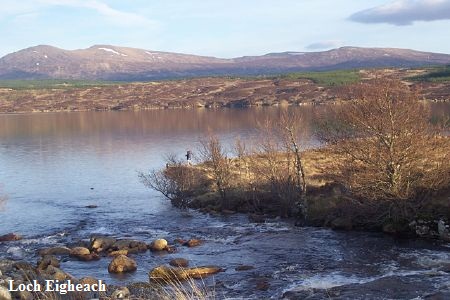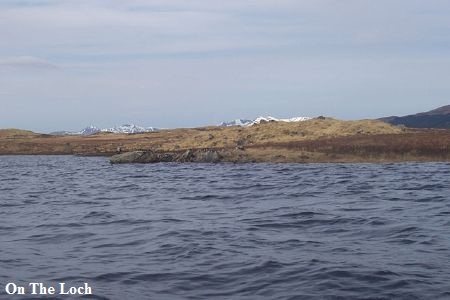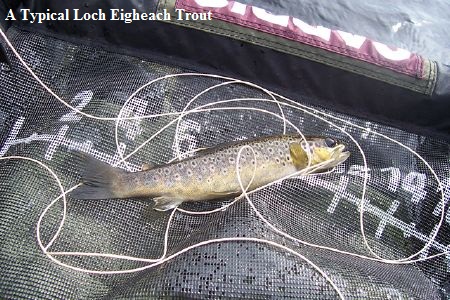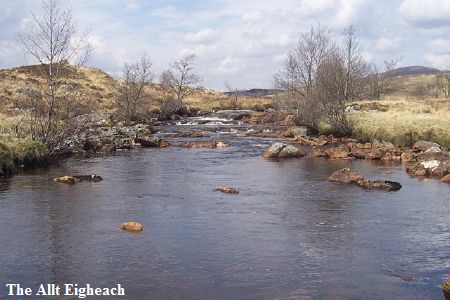Loch Eigheach and the Allt Garbh
- Details
- Published on Tuesday, 27 June 2006 20:46
- Written by David McGovern
 Legend has it that the Kelpie (or Water-Horse) that inhabited the waters of Loch Eigheach was the fiercest in Scotland after the Kelpie of Loch Treig. Happily, the trout of Eigheach’s peaty depths are equally ferocious but far, far less likely to kill you.
Legend has it that the Kelpie (or Water-Horse) that inhabited the waters of Loch Eigheach was the fiercest in Scotland after the Kelpie of Loch Treig. Happily, the trout of Eigheach’s peaty depths are equally ferocious but far, far less likely to kill you.
Some 1 mile long, the loch stands between huge Loch Laidon to the west and the giant Loch Rannoch to the east. It was enlarged greatly in the Hydro-Electric works of the 1950's and is dammed at its eastern end by the Gaur Dam. The main flow of water into the loch comes from the Allt Garbh (‘Rough’ or ‘rocky’ burn) which empties Loch Laidon. This is a classic highland stream, alternating between calm stretches where the flow has opened out and rocky torrents of awesome power, particularly in the spring when the mountain snow is still melting in the corries to the north and west.
 The Allt Garbh is bisected at its midway point by the Gaur viaduct which carries the Glasgow to Fort William line over Rannoch Moor and the viaduct can be used to cross the water and fish both banks. It’s easy to park at Rannoch Station and fish down the northern bank or to park at the Allt Eigheach and fish up towards Laidon- much less easy to fish the rough and boggy ground of the southern bank. It is productive along its entire length, containing huge numbers of lightning fast trout that will strike at any fly- but also a few larger more discerning trout which crop up in the catch returns every year.
The Allt Garbh is bisected at its midway point by the Gaur viaduct which carries the Glasgow to Fort William line over Rannoch Moor and the viaduct can be used to cross the water and fish both banks. It’s easy to park at Rannoch Station and fish down the northern bank or to park at the Allt Eigheach and fish up towards Laidon- much less easy to fish the rough and boggy ground of the southern bank. It is productive along its entire length, containing huge numbers of lightning fast trout that will strike at any fly- but also a few larger more discerning trout which crop up in the catch returns every year.
The most reliable pool for me is the one immediately below the viaduct. The water changes direction slightly and funnels into a narrow riffle near the far bank. This faster water runs the length of the pool and has given me several fish over the pound mark. A fish over 3lb was landed on a spinner here some years ago.
Early season on the Allt Garbh is very rewarding but Rannoch Moor in early spring can be inhospitable. While fishing here 2 years ago, a ferocious storm blew down Loch Laidon and caught me out above the viaduct where there is little in the way of shelter. I ran down to the viaduct to shelter as a biting wind drove snow across the moor. Cowering in the lee of the stone bridge supports I found an ancient iron ladder that led up to the railway workers storm shelter. How many times had it provided shelter in similar conditions? A cast-iron kettle on a stone shelf disintegrated in my fingertips.
The Allt Garbh slows and widens quite abruptly and empties into Loch Eigheach. The slower water in its final stretch is stappit with small trout which are frequently harried by the resident shoals of perch. A silver butcher fished in the right spot will rarely complete its journey unmolested. 
Loch Eigheach itself is often described as deep and foreboding. It is certainly deep in places but is not uniformly so. The 1902 bathymetrical survey of Loch Eigheach (which can be viewed on the internet) clearly shows the original depths of what was once a very straggly loch. I tend to concentrate my efforts on the land flooded by the dam. Although most visitors fish the northern bank which is accessible from the road, I much prefer the southern shore. Rarely visited, it is a rough slog to access, no matter which direction you arrive from. In fact- I find the easiest way to get there is to fin across the Loch in a float tube or paddle across in a kayak- a trip only to be contemplated in good weather.
I’ve camped several times near the ruins of Ceanncoille (the head of the wood) on the southern shore. This is probably the only usable camping spot on what is very rough ground, alternating between boggy holes and jagged rocks. Ceanncoille was originally a stronghold of the clan Menzies and standing at the edge of the Black Wood of Rannoch in notorious bandit country on the road to the isles, I imagine it saw a bit of action over the centuries when law and order were a fashion for the lowlands. The house was last used in the fifties before the arrival of the hydro boys. Amongst the ruins, you can still find the old iron bed. The old road that connected the homesteads of Ceanncoille and Tom a Mheirlich with the shielings at Carnach is now under the water.
 On the northern shore, fish can be encountered almost anywhere but I focus my efforts on the headlands and also where Eigheach’s other main contributing watercourse flows in, the Allt Eigheach. Good fish often lie here, particularly when the water level is high and it is easily accessed from the car park by the bridge. Other hotspots include where the old pre-hydro road disappears into the loch to re-emerge on the headland at Coille Dhunain (head of the little fort?). The course of the old road indicates fairly shallow water but wading can be dangerous as there is a lot of unstable peat just below the surface. Fish of 2 and a half pounds have been taken further along near the dam where a tunnel empties water channeled from the Allt Chaldar into the loch. This seems to be particularly productive when the water level covers the tunnel itself but its presence is easily detected by the strong flow of water.
On the northern shore, fish can be encountered almost anywhere but I focus my efforts on the headlands and also where Eigheach’s other main contributing watercourse flows in, the Allt Eigheach. Good fish often lie here, particularly when the water level is high and it is easily accessed from the car park by the bridge. Other hotspots include where the old pre-hydro road disappears into the loch to re-emerge on the headland at Coille Dhunain (head of the little fort?). The course of the old road indicates fairly shallow water but wading can be dangerous as there is a lot of unstable peat just below the surface. Fish of 2 and a half pounds have been taken further along near the dam where a tunnel empties water channeled from the Allt Chaldar into the loch. This seems to be particularly productive when the water level covers the tunnel itself but its presence is easily detected by the strong flow of water.
I’ve never been able to get a definitive answer on whether float-tubing is allowed on Eigheach so anyone contemplating using a tube here should satisfy themselves that they are not breaking the rules. They should also satisfy themselves that the weather forecast is favourable. There are no boats on Eigheach and the float tube allows you to cover fish that will otherwise never see an artificial fly. I’ve had some cracking fish from the float tube, particularly around marks such as the island near Ceanncoille but beware a strong westerly. Once you are in the narrow section that leads to the dam, there is nowhere safe to land on either shore and it once took me a full 40 minutes to fin back up the loch against a strong westerly that came out of nowhere. Dragging myself exhausted out onto the bank, I decided not to try that again.
Fly choice should be quite straightforward- the trout aren’t fussy. Small and black flies fish well on the loch itself. The machair spider is almost always on my cast here but the black pennel in smallish sizes will be attacked with gusto. In a strong wind, dabblers would be my preferred choice, particularly in claret. On the southern shore which is rockier and fringed with forestry, the wee burns can be full of nymphs in the summer so a PTN or hares ear is worth a try for the bigger fish. On the slower sections of the Allt Garbh, I like to cast a sparsely tied sedgehog or a deer hair emerger and in the faster sections a wee double butcher. But, to be honest, almost any fly will be taken in the faster water. Limited food supply and limited time to make a decision! Dapping from the tube can be spectacular but the Eigheach trout seem particularly poor at grabbing the hook. 
I’ll be back at Eigheach in the summer teaching my young son to fly-fish and I’d heartily recommend it as a perfect water to introduce a beginner to our keen wild trout. It makes for a great and varied day's fishing to take in the Allt Garbh and the main loch. Take a tent and camp at Ceancoille but take a few gallons of midgie repellent in the summer months. And remember to watch out for the kelpie.
Contact info :
Loch Eigheach is run by Rannoch and District Angling Association. Permits are available from Mrs. Brown in the square at Kinloch Rannoch. Telephone 018826 32268. A permit only costs a few pounds for a whole season, so please support the Association and make sure you buy one.

